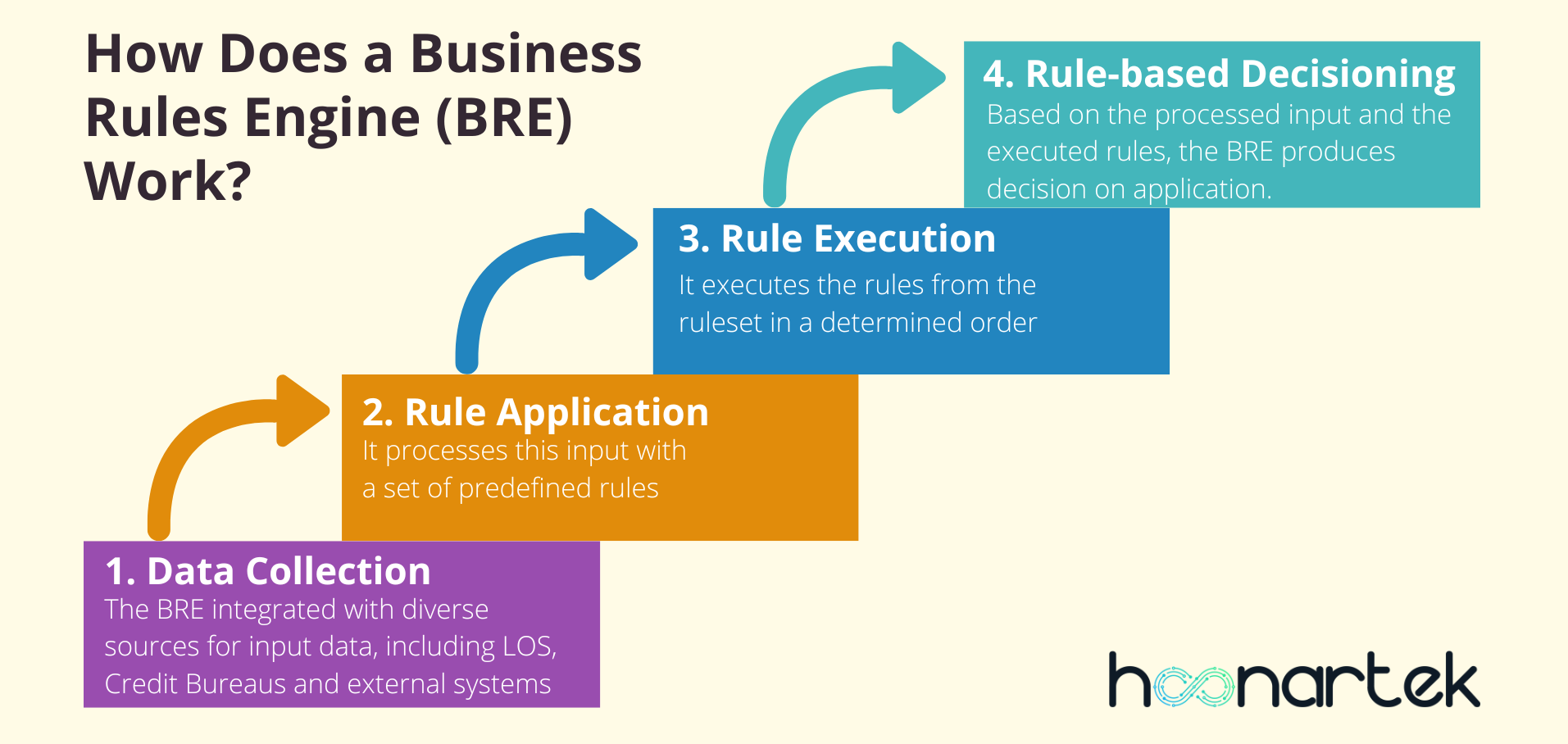Business Rules Engine – Unlock Faster, Smoother Lending Decisions
In today’s competitive financial landscape, loan approvals depend on more than just a loan officer’s intuition. This makes way for Business Rules Engine (BRE) – the invisible maestros orchestrating lending decisions with precision and speed. Think of them as silent partners, tirelessly scrutinizing data, applying pre-defined rules, and delivering accurate verdicts within seconds. Gone are the days of manual loan assessment, filled with inconsistencies and prone to human error. BREs inject logic and automation into every step, ensuring precise risk assessments, quick approvals, unbiased decisions, and dynamic adaptability.
Business Rules Engine (BRE) and Loan Origination Systems (LOS)
Loan Origination Systems (LOS) act as a catalyst for lending processes, promoting enhanced efficiency, mitigating risks, and fostering stronger customer relationships. This is powered by a Business Rules Engine (BRE), enabling businesses to define clear risk parameters and approve credit-worthy borrowers with confidence. The system delivers significant benefits, including automation, accelerated response times, precise accuracy, cost reduction, and high-performance operations.
The critical and complex logic behind business decisions, such as loan approval roles, borrower eligibility criteria, loan amount calculations, and creditworthiness assessments, lies within the BRE’s domain. This intricate decision-making engine, combined with a flexible LOS, empowers banks, NBFCs, and financial institutions to:
- Implement automated credit-decisioning models: These models leverage new data sources, analyze customer behavior, and more accurately identify underserved segments.
- Adapt to a dynamic business environment: The system’s agility allows for rapid integration of new lending opportunities and efficient responses to market changes.
- Eliminate human inconsistencies and redundancies: Automation streamlines business processes, reduces errors, and frees up resources for higher-level tasks.
In essence, LOS and BRE systems work in tandem to create a robust and adaptable lending ecosystem, paving the way for stronger customer relationships, improved performance, and sustained growth.
Business Rule Examples
Business decisions permeate everyday operations, shaping countless actions on a granular level. While their role can be subtle, well-defined rules stay invisible while orchestrating decisions towards desired outcomes within each transaction. This applies to every business system, where appropriate logic underpins every task.
Here are some examples:
- Financial Institutions: To mitigate risk and adhere to ever-evolving regulations, corporate policies, and customer expectations, these institutions rely on rules to ensure loans comply with rigorous requirements regarding insurance, documentation, and regulatory frameworks. These rules automate essential risk assessments and compliance checks.
- Retail Businesses: Customer discounts frequently depend on pre-defined business rules. For instance, a company might offer a discount to customers who spend a specific amount within a timeframe, fostering targeted customer engagement through automated incentives.
- Healthcare Providers: Determining eligibility for coverage is often guided by clear rules. Health insurance providers leverage these rules to assess potential client profiles against established criteria, ensuring accurate coverage allocation and efficient enrollment processes.
- Mortgage Lending: The extensive data gathering involved in mortgage origination, encompassing property details and borrower credit history, is often streamlined through business rules. For instance, banks might leverage rules to automate interest rate adjustments based on minimum credit score requirements, enhancing efficiency and accuracy.
Business rules act as the silent architects of countless decisions, enabling automation, consistency, and accuracy across diverse industries. By harnessing the power of these defined logics, organizations can optimize operations, mitigate risks, and ultimately ensure seamless, effective execution of their core business functions.
Revolutionize Your Credit Decisions with Hoonartek!
Automate decisions with Business Rules Engine and achieve faster approvals, reduced errors, and happier customers.
How Does a Business Rules Engine Work?
Business Rules Engines (BREs) automate decision-making processes by executing predefined rules in a specific order to achieve desired outcomes. This software is used in various contexts, including approving loan applications, or selecting the most suitable response to customer inquiries.
The core steps involved in a BRE’s operation are as follows:
- Data Collection: The BRE gathers input from diverse sources, including databases, user input, sensor data, or external systems.
- Rule Application: It processes this input in accordance with a set of predefined rules, typically stored within a “ruleset.” These rules guide decision-making processes.
- Rule Execution: The BRE executes the rules from the ruleset in a predetermined order. This order can be determined by rule priority, dependencies between rules, or other factors.
- Decision Generation: Based on the processed input and the applied rules, the Business Rule Engine (BRE) generates decisions on applications. These decisions can include approval, hold, or deferral with recommendations and action plans.

Applications of Business Rules Engines
BREs find application in domains, such as:
- Business Process Automation: They automate workflows and repetitive tasks, enhancing efficiency and reducing manual errors.
- Customer Service: They enable personalized responses and recommendations based on customer profiles and actions, fostering positive customer experiences.
- Fraud Detection: They identify suspicious patterns and anomalies in data, aiding in fraud prevention and risk mitigation.
- Data Analysis: They facilitate complex data analysis and decision-making, enabling organizations to extract valuable insights and make informed choices.
Revolutionizing Credit Decisioning
Advancements in Business Rules Engine and machine learning offer significant opportunities for banks to optimize their lending processes. Hoonartek, a leading provider of loan domain solutions, helps unlock these benefits through:
- Faster Loan Origination: Streamline the loan cycle from lead management to closing through efficient data processing and automation.
- Enhanced Risk Management: Integrate with multiple source systems and leverage robust BREs to ensure informed credit decisions and minimize risk.
- Superior Customer Service: Deliver faster response times, personalized advice, and a seamless multi-channel experience for borrowers.
- Increased Compliance and Flexibility: Ensure regulatory compliance and introduce new loan products with ease by utilizing Hoonartek’s expertise in data management and BRE implementation.
Conclusion
We at Hoonartek are committed to helping our clients embrace these advancements and achieve operational excellence. Our end-to-end solutions, covering LOS integration, BRE implementation, with expertise in data monetization, data migration, application integration and comprehensive testing, empower you to revolutionize your credit decisioning models. Let’s partner to drive sustainable growth and success for your business.

Sumit Patil
Sumit Patil is a Business Development professional with extensive experience in the BFSI domain, particularly Lending and Cards. His expertise lies in leveraging Experian's suite of products (PowerCurve, Tallyman, DaaS) to optimize loan origination processes. Sumit has a proven track record of maintaining strong client relationships, ensuring successful project delivery and exceeding customer expectations.


